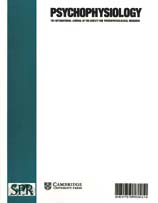Crossref Citations
This article has been cited by the following publications. This list is generated based on data provided by
Crossref.
Pulvermüller, Friedemann
2001.
Brain reflections of words and their meaning.
Trends in Cognitive Sciences,
Vol. 5,
Issue. 12,
p.
517.
Böttger, Diana
Herrmann, Christoph S
and
von Cramon, D.Yves
2002.
Amplitude differences of evoked alpha and gamma oscillations in two different age groups.
International Journal of Psychophysiology,
Vol. 45,
Issue. 3,
p.
245.
Pulvermüller, Friedemann
2002.
A brain perspective on language mechanisms: from discrete neuronal ensembles to serial order.
Progress in Neurobiology,
Vol. 67,
Issue. 2,
p.
85.
Aine, C.J.
and
Stephen, J.M.
2003.
The Cognitive Electrophysiology of Mind and Brain.
p.
93.
Pulvermüller, Friedemann
2003.
The Neuroscience of Language.
Shirahama, Yasuhiro
Ohta, Katsuya
Takashima, Atsuko
Matsushima, Eisuke
and
Okubo, Yoshiro
2004.
Magnetic brain activity elicited by visually presented symbols and Japanese characters.
NeuroReport,
Vol. 15,
Issue. 5,
p.
771.
Hillebrand, Arjan
Singh, Krish D.
Holliday, Ian E.
Furlong, Paul L.
and
Barnes, Gareth R.
2005.
A new approach to neuroimaging with magnetoencephalography.
Human Brain Mapping,
Vol. 25,
Issue. 2,
p.
199.
Pammer, Kristen
Hansen, Peter
Holliday, Ian
and
Cornelissen, Piers
2006.
Attentional shifting and the role of the dorsal pathway in visual word recognition.
Neuropsychologia,
Vol. 44,
Issue. 14,
p.
2926.
Simon, Grégory
Bernard, Christian
Lalonde, Robert
and
Rebaï, Mohamed
2006.
Orthographic transparency and grapheme–phoneme conversion: An ERP study in Arabic and French readers.
Brain Research,
Vol. 1104,
Issue. 1,
p.
141.
Fiorentino, Robert
and
Poeppel, David
2007.
Compound words and structure in the lexicon.
Language and Cognitive Processes,
Vol. 22,
Issue. 7,
p.
953.
Hannemann, R.
Obleser, J.
and
Eulitz, C.
2007.
Top-down knowledge supports the retrieval of lexical information from degraded speech.
Brain Research,
Vol. 1153,
Issue. ,
p.
134.
HOYA, TETSUYA
2008.
MODELLING NEURONAL GRAMMAR CIRCUITS.
ENGLISH LINGUISTICS,
Vol. 25,
Issue. 2,
p.
475.
Xue, Gui
Jiang, Ting
Chen, Chuansheng
and
Dong, Qi
2008.
Language experience shapes early electrophysiological responses to visual stimuli: The effects of writing system, stimulus length, and presentation duration.
NeuroImage,
Vol. 39,
Issue. 4,
p.
2025.
Gruber, T.
Maess, B.
Trujillo-Barreto, N.J.
and
Müller, M.M.
2008.
Sources of synchronized induced Gamma-Band responses during a simple object recognition task: A replication study in human MEG.
Brain Research,
Vol. 1196,
Issue. ,
p.
74.
Brem, Silvia
Halder, Pascal
Bucher, Kerstin
Summers, Paul
Martin, Ernst
and
Brandeis, Daniel
2009.
Tuning of the visual word processing system: Distinct developmental ERP and fMRI effects.
Human Brain Mapping,
Vol. 30,
Issue. 6,
p.
1833.
Maurer, Urs
Blau, Vera C.
Yoncheva, Yuliya N.
and
McCandliss, Bruce D.
2010.
Development of Visual Expertise for Reading: Rapid Emergence of Visual Familiarity for an Artificial Script.
Developmental Neuropsychology,
Vol. 35,
Issue. 4,
p.
404.
Zhang, Mingxia
Jiang, Ting
Mei, Leilei
Yang, Hongmin
Chen, Chuansheng
Xue, Gui
and
Dong, Qi
2011.
It's a word: Early electrophysiological response to the character likeness of pictographs.
Psychophysiology,
Vol. 48,
Issue. 7,
p.
950.
Pulvermüller, Friedemann
2012.
Meaning and the brain: The neurosemantics of referential, interactive, and combinatorial knowledge.
Journal of Neurolinguistics,
Vol. 25,
Issue. 5,
p.
423.
Signoret, Carine
Gaudrain, Etienne
and
Perrin, Fabien
2013.
Similarities in the neural signature for the processing of behaviorally categorized and uncategorized speech sounds.
European Journal of Neuroscience,
Vol. 37,
Issue. 5,
p.
777.
Fraga González, Gorka
Žarić, Gojko
Tijms, Jurgen
Bonte, Milene
Blomert, Leo
and
van der Molen, Maurits W.
2014.
Brain-potential analysis of visual word recognition in dyslexics and typically reading children.
Frontiers in Human Neuroscience,
Vol. 8,
Issue. ,

